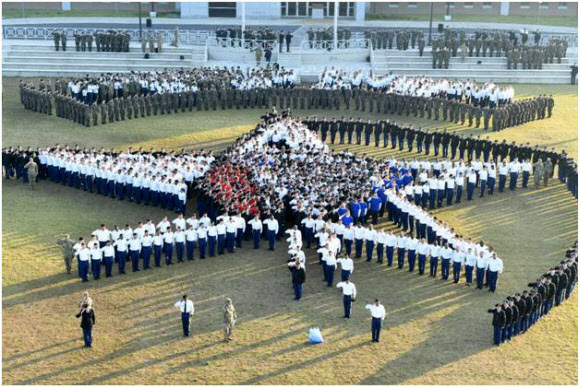 |
|
The USFK 2nd Infantry Division and the ROK-US Combined Division form a star at the Camp Humphreys garrison in Pyeongtaek, Gyeonggi Province, on May 15. (Yonhap News)
|
S. Korean government says final conclusion yet to be reached
US Forces Korea (UFSK) proposed the relocation of the ROK-US Combined Forces Command (CFC) headquarters from Yongsan Garrison in Seoul to its Camp Humphreys garrison in Pyeongtaek, Gyeonggi Province, rather than to within the South Korean Ministry of National Defense (MND) complex, it was discovered on May 16. The South Korean and US sides had initially selected the MND complex as a relocation site for CFC and held concrete discussions to select a candidate building to house it. “USFK recently communicated a position regarding the issue of relocating CFC from Yongsan Garrison,” a South Korean government official said. “They seem to favor bringing it to the garrison at Pyeongtaek rather than relocating it within the MND complex,” the official explained. Adding that the matter was “currently being discussed by South Korea and the US,” the official stressed, “No final conclusion has been reached.” To date, the two sides have discussed situating CFC within the MND complex. At their 49th Security Consultative Meeting (SCM) in October 2017, then Minister of National Defense Song Young-moo and US Secretary of Defense James Mattis agreed on the MND complex relocation plan, with then CFC Commander Vincent Brooks signing a memorandum of understanding (MoU) late that year. At the time, Brook stressed that CFC would be remaining in Seoul, adding that its location alongside the MND and Joint Chiefs of Staff headquarters within the complex would enable to focus all the South Korea-US alliance’s military strength in one place. Plan to relocate to MND disrupted by new CFC commander But the situation changed when Robert Abrams became CFC Commander in November 2018. According to reports, Abrams proceeded with a full-scale reexamination of the MND complex relocation plan for CFC, communicating to the ministry that an independent building capable of accommodating at least 200 staffers would be needed. Abrams also personally toured some of the candidate sites mentioned for the CFC relocation within the MND complex in January, including the Joint Chiefs of Staff building, the JCS-affiliated Joint Warfighting Simulation Center (JWSC), the MND facility headquarters, and the service support group building. USFK’s proposal to relocate CFC to Pyeongtaek reportedly came after Abrams’ examination of the MND complex. According to sources, the reasons cited by the US military included the massive costs of establishing accommodations in central Seoul for US military advisors and their family members if the CFC headquarters were relocated within the MND complex. It was also reportedly argued that outstanding advisors would not support duties if families ended up split between Seoul and Pyeongtaek due to the inability to find housing. The US military additionally expressed that problems in communication with the South Korean military could arise if CFC were relocated to the Pyeongtaek garrison, sources said. Relocation to Camp Humphreys could complicate OPCON transfer Some are arguing that the relocation of CFC to Pyeongtaek could undercut the aims of the wartime operational control (OPCON) transfer in terms of returning leadership to the South Korean military. Once the OPCON transfer takes place, CFC Commander duties are likely to be assumed by the South Korean JCS Chairman. The presence of CFC on a US military base could pose a constraint to the JCS Chairman exercising authority. Another potential problem is the possibility of the JCS chairman having to travel back and forth between Seoul and Pyeongtaek while commanding CFC. “The CFC relocation is not a simple matter of moving,” a military official said. “It requires some very complex political and operational judgments,” the official added. In a press release that day, CFC said the decision on the relocation would be made within the framework of Military Committee Meetings (MCM) and Security Consultative Meetings (SCM) for decisions by the South Korea-US alliance, adding that staff-level discussions were ongoing. CFC also quoted Abrams as saying, “At the appropriate future time, ROK and US government leadership will announce an alliance decision on the future CFC headquarters location, which will be in the best interests of the ROK-US Alliance and strengthen CFC’s ability to perform its missions.” By Yoo Kang-moon, senior staff writer Please direct comments or questions to [english@hani.co.kr]






